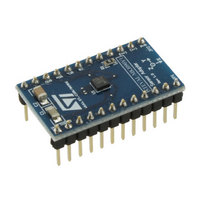STEVAL-MKI090V1 STMicroelectronics, STEVAL-MKI090V1 Datasheet - Page 18

STEVAL-MKI090V1
Manufacturer Part Number
STEVAL-MKI090V1
Description
DEMO BOARD FOR LIS331DLF
Manufacturer
STMicroelectronics
Series
MEMS, nanor
Datasheets
1.STEVAL-MKI009V1.pdf
(42 pages)
2.STEVAL-MKI090V1.pdf
(38 pages)
3.STEVAL-MKI090V1.pdf
(4 pages)
Specifications of STEVAL-MKI090V1
Sensor Type
Accelerometer, 3 Axis
Sensing Range
±2g, 4g, 8g
Interface
I²C, SPI
Sensitivity
16LSB/g, 8LSB/g, 4LSB/g
Embedded
No
Utilized Ic / Part
LIS331DLF
Acceleration
2 g, 4 g, 8 g
Sensing Axis
Triple Axis
Interface Type
I2C, SPI
Lead Free Status / RoHS Status
Lead free / RoHS Compliant
Voltage - Supply
-
Lead Free Status / Rohs Status
Lead free / RoHS Compliant
For Use With/related Products
LIS331DLF
Other names
497-10492
Available stocks
Company
Part Number
Manufacturer
Quantity
Price
Company:
Part Number:
STEVAL-MKI090V1
Manufacturer:
STMicroelectronics
Quantity:
135
Digital interfaces
5.1.1
18/38
I
The transaction on the bus is started through a START (ST) signal. A START condition is
defined as a HIGH to LOW transition on the data line while the SCL line is held HIGH. After
this has been transmitted by the Master, the bus is considered busy. The next byte of data
transmitted after the start condition contains the address of the slave in the first 7 bits and
the eighth bit tells whether the Master is receiving data from the slave or transmitting data to
the slave. When an address is sent, each device in the system compares the first seven bits
after a start condition with its address. If they match, the device considers itself addressed
by the Master.
The slave address (SAD) associated to the LIS331DLF is 010100xb. SDO/SA0 pad can be
used to modify less significant bit of the device address. If SA0 pad is connected to voltage
supply, LSb is ‘1’ (address 0101001b) else if SA0 pad is connected to ground, LSb value is
‘0’ (address 0101000b). This solution permits to connect and address two different
accelerometers to the same I
Data transfer with acknowledge is mandatory. The transmitter must release the SDA line
during the acknowledge pulse. The receiver must then pull the data line LOW so that it
remains stable low during the HIGH period of the acknowledge clock pulse. A receiver which
has been addressed is obliged to generate an acknowledge after each byte of data
received.
The I
protocol must be adhered to. After the start condition (ST) a slave address is sent, once a
slave acknowledge (SAK) has been returned, a 8-bit sub-address (SUB) is transmitted: the
7 LSb represent the actual register address while the MSB enables address auto increment.
If the MSb of the SUB field is ‘1’, the SUB (register address) is automatically increased to
allow multiple data read/write.
The slave address is completed with a Read/Write bit. If the bit was ‘1’ (Read), a repeated
START (SR) condition must be issued after the two sub-address bytes; if the bit is ‘0’ (Write)
the Master will transmit to the slave with direction unchanged.
SAD+Read/Write bit pattern is composed, listing all the possible configurations.
Table 10.
Table 11.
2
C operation
Master
Slave
2
Command
C embedded inside the LIS331DLF behaves like a slave device and the following
Read
Write
Read
Write
SAD+Read/Write patterns
Transfer when master is writing one byte to slave
ST
SAD + W
SAD[6:1]
010100
010100
010100
010100
2
C lines.
Doc ID 15101 Rev 4
SAK
SAD[0] = SA0
0
0
1
1
SUB
SAK
Table 10
R/W
1
0
1
0
DATA
01010001 (51h)
01010000 (50h)
01010011 (53h)
01010010 (52h)
explains how the
SAD+R/W
SAK
LIS331DLF
SP




















